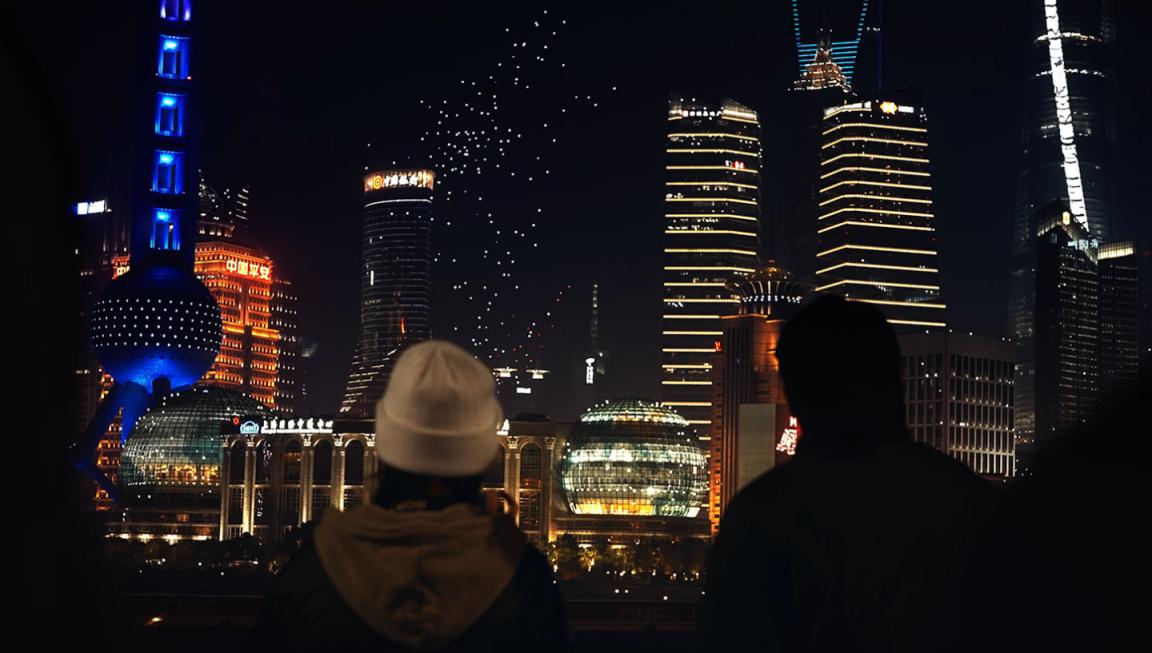How Do Drone Light Shows Work? A Behind-the-Scenes Look at Sky’s Smartest Spectacle
Drone light shows are captivating audiences across the world, offering a sustainable, programmable alternative to traditional fireworks. These synchronized swarms of light-emitting drones form massive animations, logos, and 3D visuals in the night sky. But how exactly do drone light shows work? What goes on behind the scenes to make thousands of drones fly in perfect harmony?
In this blog post, we’ll explore the step-by-step process behind a drone light show, from design to execution, and explain the technology that powers this stunning blend of engineering and artistry.
1. What Is a Drone Light Show?
A drone light show involves a fleet (or “swarm”) of small, LED-equipped drones that fly in pre-programmed formations to create moving visuals and images in the sky. Shows typically include:
-
Logos and brand symbols
-
Text messages and countdowns
-
Animals, objects, or mascots
-
Abstract shapes or storytelling sequences
Each drone acts as a pixel in a giant 3D display, and when hundreds—or even thousands—are used, the result is a high-resolution image visible from miles away.
2. Core Components of a Drone Light Show
a. Drones
Specialized drones are used for light shows. These units are:
-
Lightweight (often under 1kg)
-
Equipped with RGB LED lights
-
GPS/RTK-enabled for precise positioning
-
Capable of flying in formation for 10–20 minutes
Some leading manufacturers, like Damoda, Verge Aero, and Intel, design drones specifically for shows, with high endurance and weather resistance.
b. Ground Control System
A centralized ground station handles:
-
Launch and return sequences
-
Real-time communication and telemetry
-
Emergency override capabilities
-
Synchronization with audio tracks (if needed)
These systems rely on encrypted RF communication, GPS/RTK for pinpoint accuracy, and software that allows for collision-avoidance and signal redundancy.
c. Choreography & Animation Software
Designing the visual elements is often the most time-consuming part of a drone light show. Animation teams use 3D modeling software to:
-
Create flight paths for each drone
-
Assign color, position, and timing
-
Simulate the show using virtual previews
Common tools include Blender, After Effects, and proprietary flight simulation platforms. The key is ensuring each drone’s path is unique and avoids intersecting with others—a computationally complex task.
3. The Step-by-Step Process
Step 1: Creative Planning
Everything starts with a concept. Whether it’s a New Year’s celebration or a brand launch, designers gather input about the message and visual goals. Clients often provide logos, slogans, or brand identity visuals to incorporate into the show.
Step 2: 3D Design and Simulation
Using animation software, artists create visuals in 3D space. These are then translated into flight paths for each drone. The team tests timing, transitions, and color palettes, and runs simulations to preview the result virtually.
Step 3: Pre-Flight Testing
Before the show, a smaller-scale test may be conducted on the ground or using a partial fleet. This ensures that:
-
All drones respond correctly
-
GPS and RTK signals are working
-
Software is free from errors
-
Battery performance is optimal
Step 4: Site Prep and Safety Checks
The show location must be cleared of obstacles, and necessary flight permissions must be obtained from aviation authorities (e.g., FAA in the U.S.). Ground teams assess:
-
Weather conditions (wind, rain, temperature)
-
No-fly zones
-
Safe launch/landing zones
-
Audience viewing angles and distance
Step 5: Flight Execution
On the night of the show:
-
Drones are charged and positioned in a launch grid
-
The control team uploads flight scripts
-
Safety checks are performed
-
The show begins—automatically synchronized to music if needed
Most shows last between 8–15 minutes. Drones take off, ascend to predetermined altitudes, and then begin forming visual sequences, often with smooth transitions and storytelling elements.
Step 6: Post-Show Procedures
After landing, drones are inspected, logged, and recharged. The flight data is stored for performance review, and clients often receive a post-show package including video footage, drone flight paths, and technical logs.
4. Technology That Makes It Possible
-
GPS + RTK (Real-Time Kinematic Positioning): Enables centimeter-level accuracy, which is critical when 500+ drones are flying inches apart.
-
Mesh Networking or Central Control Links: Ensures continuous drone-to-ground communication. Some systems use peer-to-peer (mesh) while others rely on a central base station.
-
Failsafe Protocols: If a drone loses signal, it’s programmed to safely land or hover. Geofencing also prevents them from flying into restricted areas.
-
AI Algorithms: Increasingly, AI is used to optimize flight paths, manage large-scale coordination, and respond to in-flight conditions like wind.
5. Common Use Cases for Drone Shows
-
Public Events: New Year’s Eve, national holidays, city festivals
-
Corporate Launches: Product reveals, branding activations
-
Sports & Entertainment: Opening ceremonies, halftime shows
-
Theme Parks: Daily or seasonal drone displays
-
Private Events: Weddings, proposals, and memorial tributes
6. Advantages Over Fireworks
| Feature | Drone Show | Fireworks |
|---|---|---|
| Eco-Friendly | ✅ No pollution | ❌ Emits smoke/debris |
| Noise Level | ✅ Silent operation | ❌ Loud explosions |
| Reusability | ✅ Programmable | ❌ One-time use |
| Custom Design | ✅ Fully customizable | ❌ Limited variation |
| Safety | ✅ Controlled flight | ❌ Fire hazard |
This makes drone shows especially attractive for urban centers, schools, hospitals, and environmentally sensitive areas.
7. How Many Drones Do You Need?
-
Small show (50–100 drones): Text and simple shapes
-
Medium show (200–500 drones): Logo sequences and animation
-
Large show (600–2,000 drones): Full storytelling and 3D visuals
-
Mega shows (5,000+ drones): World record-scale events and international ceremonies
Each drone typically adds $250–$500 to the cost, depending on the provider, tech level, and duration.
8. Challenges and Limitations
-
Weather Dependence: Heavy wind or rain can ground a show.
-
Battery Life: Most drones can only fly 15–20 minutes per show.
-
Signal Interference: Urban environments may pose challenges.
-
Airspace Restrictions: Certain cities or areas may require weeks of advance permitting.
Conclusion: A Future-Focused Form of Entertainment
Drone light shows combine aerospace technology, artistic design, and real-time computing in a way that was unimaginable a decade ago. Whether you're a business looking to wow your audience or a city planning its next public celebration, drone shows offer a cleaner, smarter, and more flexible way to light up the skies.











